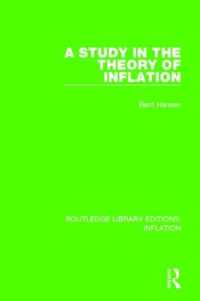- ホーム
- > 洋書
- > 英文書
- > Nature / Ecology
Full Description
This book features four peer-reviewed reviews on understanding and conserving pollinators.
The first chapter provides a brief overview on pollinators and the ecosystem services they offer, as well as the role of data collection and sharing in achieving more sustainable farming and beekeeping practices. The chapter also considers how existing data collected by farm management systems can be used to ascertain the impact of particular agricultural practices on pollinators and key pollinator services.
The second chapter summarises the variety of ways in which bee species are managed for optimal pollination of crops and harvest of honey, beeswax and other products. The chapter also reviews methods to encourage biodiversity and populations of indigenous pollinating insects.
The third chapter considers using network ecology to understand, support and enhance pollination services through farm management and integrated decision-making. The chapter also addresses how these networks can be assessed from field to national scales.
The final chapter reviews the role of habitat conservation and restoration for solitary bee species. The chapter addresses key challenges facing habitat restoration, such as changes in global temperature and precipitation, as well as the effectiveness of existing restoration projects in the European Union and North America.
Contents
Chapter 1 - Using data to assess the impact of agriculture on pollinators and pollinator services: Noa Simón Delso, BeeLife European Beekeeping Coordination, Belgium; and Walter Haefeker, European Professional Beekeepers Association, Germany;
1 Introduction
2 Current data on pollinators
3 Farm data standardization
4 Data standardization in beekeeping
5 Data sharing in farming
6 Data sharing in beekeeping
7 Solutions to data sharing
8 Conclusion
9 Competing interests
10 Where to look for further information
11 References
Chapter 2 - Organic and natural beekeeping, and caring for insect pollinators: Nicola Bradbear, Bees for Development, UK;
1 Introduction
2 The need for pollinators
3 Encouraging indigenous pollinators
4 Management of bees
5 Management of honey bees
6 Management of bumblebees
7 Conclusion
8 References
Chapter 3 - Ecological network approaches for promoting pollinators in agriculture: Darren M. Evans and Fredric M. Windsor, Newcastle University, UK;
1 Introduction
2 Plantpollinator networks
3 Networks across scales
4 Increasing the completeness of pollination networks
5 Embedding pollination within wider agro-ecosystem networks
6 Next steps for pollination networks
7 Conclusion
8 Where to look for further information
9 Acknowledgements
10 References
Chapter 4 - The role of habitat conservation and restoration in protecting pollinators in agricultural landscapes: Stephen Buchmann, University of Arizona, USA;
1 Introduction
2 Bees as pollinators
3 Challenges in habitat restoration
4 Assessing the effectiveness of habitat restoration
5 Case studies
6 Conclusion
7 Where to look for further information
8 References







